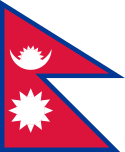Igrzyska Azjatyckie 1982
| |||
| |||
| Stolica igrzysk | Nowe Delhi | ||
| Liczba ekip | 33 | ||
| Liczba sportowców | ok. 5000 | ||
| Liczba konkurencji | 22 | ||
| Otwarcie | 19 listopada 1982 | ||
| Zamknięcie | 4 grudnia 1982 | ||
| Oficjalne otwarcie | Giani Zail Singh | ||
| Przysięga olimpijska | P. T. Usha | ||
| Znicz olimpijski | Balbir Singh Deanna Syme Tewari | ||
| Stadion | Jawaharlal Nehru Stadium | ||
| Zwycięzca klasyfikacji medalowej: | |||
IX Igrzyska Azjatyckie – zawody sportowe państw azjatyckich, które odbyły się w dniach 19 listopada-4 grudnia 1982 w stolicy Indii, Nowym Delhi. Były to drugie igrzyska azjatyckie odbywające się w tym mieście. Po raz pierwszy sportowcy rywalizowali w Nowym Delhi w 1951 roku. W programie igrzysk znajdowały się 22 dyscypliny. Była to pierwsza edycja igrzysk azjatyckich zorganizowana pod egidą Olimpijskiej Rady Azji[1].
Uczestnicy igrzysk
W IX Igrzyskach Azjatyckich wzięły udział 33 reprezentacje, będące członkami Międzynarodowego Komitetu Olimpijskiego.
Konkurencje sportowe na IA 1982
IX Igrzyska Azjatyckie rozgrywano w 22 dyscyplinach sportowych.
|
|
|
Klasyfikacja medalowa
| Miejsce | Reprezentacja | Łącznie | |||
|---|---|---|---|---|---|
| 1 | 61 | 51 | 41 | 153 | |
| 2 | 57 | 52 | 44 | 153 | |
| 3 | 28 | 28 | 37 | 93 | |
| 4 | 17 | 19 | 20 | 56 | |
| 5 | 13 | 19 | 25 | 57 | |
| 6 | 4 | 4 | 7 | 15 | |
| 7 | 4 | 4 | 4 | 12 | |
| 8 | 3 | 3 | 5 | 11 | |
| 9 | 3 | 3 | 1 | 7 | |
| 10 | 2 | 3 | 9 | 14 | |
| 11 | 2 | 3 | 4 | 9 | |
| 12 | 1 | 5 | 4 | 10 | |
| 13 | 1 | 3 | 3 | 7 | |
| 14 | 1 | 1 | 1 | 3 | |
| 15 | 1 | 0 | 3 | 4 | |
| 16 | 1 | 0 | 2 | 3 | |
| 17 | 0 | 1 | 0 | 1 | |
| 18 | 0 | 0 | 1 | 1 | |
| 19 | 0 | 0 | 1 | 1 | |
| 20 | 0 | 0 | 1 | 1 | |
| 21 | 0 | 0 | 1 | 1 | |
| 22 | 0 | 0 | 1 | 1 | |
| Razem | 199 | 199 | 215 | 613 | |
Przypisy
- ↑ 1982: High On Drama (ang.)
Linki zewnętrzne
Media użyte na tej stronie
Autor: https://phabricator.wikimedia.org/diffusion/GOJU/browse/master/AUTHORS.txt, Licencja: MIT
An icon from the OOjs UI MediaWiki lib.
Autor: https://phabricator.wikimedia.org/diffusion/GOJU/browse/master/AUTHORS.txt, Licencja: MIT
An icon from the OOjs UI MediaWiki lib.
The Flag of India. The colours are saffron, white and green. The navy blue wheel in the center of the flag has a diameter approximately the width of the white band and is called Ashoka's Dharma Chakra, with 24 spokes (after Ashoka, the Great). Each spoke depicts one hour of the day, portraying the prevalence of righteousness all 24 hours of it.
bendera Indonesia
Flag of Laos
Flag of Maldives. The colours used are Pantone 186 C for red and Pantone 348 C for green.
Łatwo można dodać ramkę naokoło tej grafiki
The national flag of Kingdom of Thailand since September 2017; there are total of 3 colours:
- Red represents the blood spilt to protect Thailand’s independence and often more simply described as representing the nation.
- White represents the religion of Buddhism, the predominant religion of the nation
- Blue represents the monarchy of the nation, which is recognised as the centre of Thai hearts.
This is the flag of Bahrain used from 1972 until 2002. The base image is from the 2002 CIA World Factbook (mirrored at UMSL). I have removed the border and recolored the red section according to Image:Flag of Bahrain.svg.
Flag of the Philippines in the previous official shade of Cable No. 80176 or Oriental Blue. In use for 9 months from from May, 1985, to February 25, 1986.
Flag of the Democratic Republic of Afghanistan (1980-1987). Aspect ratio: 2:1.
Flag of Iraq, 1963-1991. Also flag of Syria, 1963-1972.





































